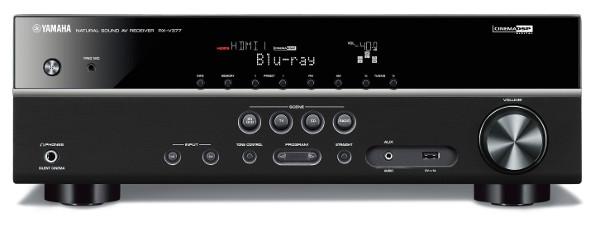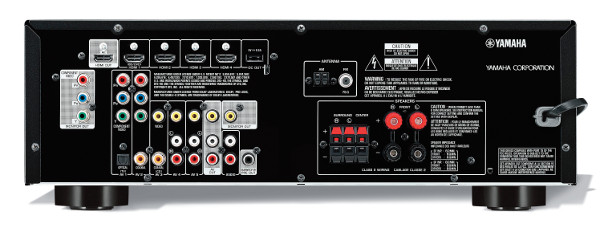Yamaha RX-V377 AV Receiver

At A Glance
Plus
Five amp channels
Virtual Cinema Front
Darkish tonal balance
Minus
Bargain-basement speaker terminals
No wireless or network audio features
The Verdict
The Yamaha RX-V377 is an accessibly priced entry-level receiver with most of the essential features and mercifully dark-toned voicing.
If you think surround sound is just for the well-to-do, think again. The Top Picks page on this site is loaded with compact 5.1-channel speaker systems, starting at $520 for a setup based on the Pioneer SP-BS522 monitors, designed by loudspeaker guru Andrew Jones. Cheap Blu-ray players abound, these days. All you’d need to do is add another $300 for something like the Yamaha RX-V377 receiver, reviewed here, and your starter system weighs in at under a grand (and those are list prices).
Yamaha has several lines of AV receivers, of which the most populous are the higher-end Aventage series, priced at $700 to $2,200, and the RX-V series, priced at $300 to $850. If you want a high-performing receiver, Aventage would be an excellent place to look. But if you’re on a tighter budget, check out the RX-V models. The RX-V377 is the newest junior member, replacing the outgoing RX-V375. It’s not often that I review a $300 receiver. So the question on my mind was: What do you give up when reaching down to this price point?
 Five Are Enough
Five Are Enough
The first answers that come to mind are channels and watts. This receiver has five—not seven&mdashlamplifier channels rated at 70 watts with two channels driven. (See the Test Bench for five-channel measurements.) This isn’t necessarily a deal breaker, especially for a home theater neophyte. Five amp channels are all you need for basic surround sound. The pending (and as yet, unproven) Dolby Atmos format notwithstanding, most people, myself included, don’t need or want back-surround, height, or width channels. And if your speakers are sensitive (or efficient) enough, this receiver should be able to drive five of them to reasonably high levels in smaller rooms. It did acceptably well with my Paradigms, which are of middling sensitivity (87 decibels).
On the other hand, if wireless connectivity is important to you, be warned that this receiver has almost none. I said almost—a back-panel port does support an extra-cost Bluetooth adapter, the YBA-11. At $70, it’s priced below the $130 model it replaces. Yes, you can buy other Bluetooth adapters for even less, but Yamaha’s is powered by the port. This receiver doesn’t support Apple AirPlay, but the front-panel USB jack is iOS capable. There’s no Ethernet port or Wi-Fi reception for DLNA connection to computers and other devices on a home network.
On the back panel are further compromises, but still plenty of basic functionality. The receiver has four HDMI inputs and one output, probably more than a $300 receiver buyer will ever need. Additional HD-capable connectivity comes via component video jacks, one in and one out. Incidentally, the 4K video processing includes passthrough but not scaling. There are enough composite video, stereo analog, and coaxial/optical digital jacks to support a small armada of legacy components. If you need IR remote or RS-232 jacks, this receiver might curb your custom-install aspirations, but I’m guessing that’s not an issue at this price point.
The speaker terminals worried me. Yamaha uses two different kinds: good collared binding posts (for the front left and right channels) and bad spring-loaded wire clips (for the center and surround left/right channels). I attached my usual Monster 1.2s banana-plug cables to the binding posts. The wire clips weren’t large enough to accept any of several 12-gauge generic cables, so I was forced to use slender 18-gauge with bare tips at the amp end. I still fretted that the skinnier cable would cause a qualitative change. Yamaha commented that trimming costs on the binding posts “allows more money to be put into other areas, such as power supply and DSP processing. It can be much more difficult to design an entry-level receiver, with its tight budget constraints, than a flagship sky’s-the-limit receiver.”
In a receiver with few features, little ones may be worth mentioning. Yamaha provides an unusual Virtual Cinema Front mode that uses a 5.1-channel speaker array but moves the surround speakers to the front of the room, where it is said a surprising number of neophytes mistakenly plunk all five anyway. There’s a remote-enabled Extra Bass booster, if you want more bass, and a Subwoofer Trim control, if you want less. Yamaha’s Scene controls enable you to bundle inputs with settings assigned to one of four specific buttons.

Yamaha’s YPAO auto setup was routine. As most receivers do, this one pegged my speakers as large and set a 60-hertz crossover. (Many other receivers choose 40 Hz, but no big deal.) I reset the speakers to small with an 80-Hz crossover, as always, to prevent bass from collapsing the soundfield during challenging moments. This can help any receiver, and with a lower-powered one, it’s an imperative if you have an amplified subwoofer. Note that this version of YPAO is auto setup only—no room correction. That starts with the RX-V677 ($650) and continues up the line.
Associated equipment included five Paradigm Reference Studio 20 v.4 speakers, Paradigm Seismic 110 subwoofer, Oppo BDP-83SE universal disc player, Micro Seiki BL-21 turntable, Shure V15MxVR/N97XE cartridge, and Onix OA 21s integrated amp serving as phono preamp. All movie demos were on Blu-ray Disc.
Discretion
One expects the cheapest receivers to sound nasty, but the RX-V377 refused to be typecast. Its balance of frequencies was pleasingly dark-toned, with a mercifully rolled-off top end. At this price range, that isn’t a bad thing. A more detailed top end would be one of the benefits of buying a higher-priced model, but in this case, discretion was the better part of valor. Lackluster highs beat nasty ones every time. Bass response was sufficient for male voices and chamber or piano music.
Vocal reproduction is job one for a surround receiver, and in this category, the Yamaha was a less than perfectly balanced performer. Promised Land (DTS-HD Master Audio) stars Matt Damon as an energy-industry front man struggling with drilling licenses and moral conflicts. The story places him in several public-speaking situations. In those scenes, dialogue was intended to be a multichannel phenomenon, but the ambience tended to creep up on the center image, intermittently pulling speaking voices toward the surround channels. With the reticent top end, the bass component of voices (especially male ones) was more prominent, making them unnaturally chesty.





























































